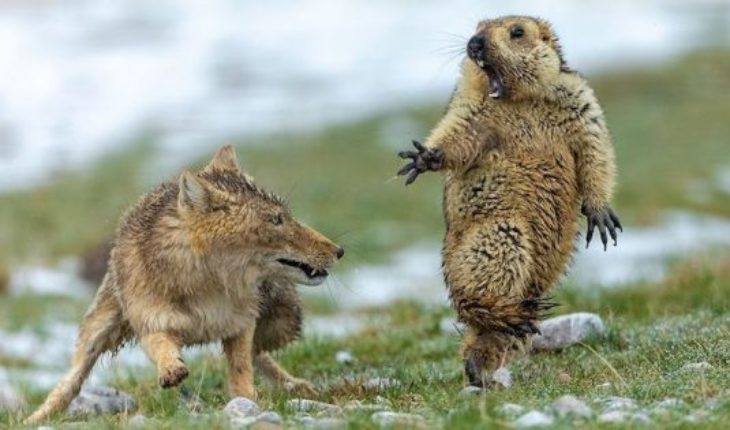The fox surprised the groundhog and what we see is the moment before a battle that ended with the death of the rodent.
Even the intervention of the mother of the groundhog could not change the outcome of the encounter.
“That’s Nature,” said Yongqing Bao, the author of this shocking lead award-winning image in the Wildlife Photographer of the Year (WPY) competition.
Yongqing also shared the first place in the mammalian category with this image.
Persistence is key in wildlife photography, and Yongqing waited for hours in a meadow on the Tibetan plateau to capture the right moment.
The fox had lay motionless in the hope of catching some groundhog passing through the place.
The strategy worked. In another image of the sequence you can see the fox with the groundhog head in its mouth.
In photos: the most comical images of wild nature
“The competition receives images that show animal behavior in an unparalleled way,” stressed Kidman Cox, who chaired the JURY of the WPY, one of the world’s most prestigious wildlife photography competitions.
“Great photographers in this field around the world always participate and I must say that this is one of the best images I’ve ever seen,” he concluded.
The young photographer award went to Cruz Erdmann for his nightly image of a reef squid in the Lembeh Strait in Indonesia’s North Sulawesi Province. Cruz participated in the 11 to 14 year old category.
Cruz Erdmann won in the category of photographers from 11 to 14 years with this night image of a reef squid. Image copyright Cruz ErdmannAchieving a clear image of the iridescent cephalopod requires a great technical skill.
“You must be careful not to shake the sediments when diving, or there will be a lot of strobe scattering,” Erdmann said.
The strobe is a device that emits luminous flashes at a predetermined frequency. This makes you see an object that rotates at high speed as if it were motionless or spinning very slowly.
It took Audun Rikardsen three years to get this picture of a golden eagle. Image copyright Audun RikardseThe image “Land of the Eagle” by Audun Rikardsen, Norway, was the winner in the Behavior: Birds category.
It took Audun three years to achieve this image. The photographer had carefully placed a branch in a place that the golden eagles used to reach.
Audun also placed a flash and camera that would be fired automatically if the bird was perched.
“The eagles got so used to the flash trigger, it didn’t bother them. I think they like to be taken pictures.”
The crows also perched on the branch, but they were not the birds that the Norwegian photographer wanted to catch.
More than 5,000 emperor penguins congregate in Antarctica in this photo by German Stefan Christmann. Image copyright Stefan Christmann”The Hug” is the title of this photograph by Stefan Christmann, from Germany, winner in the Portfolio category.
More than 5,000 emperor penguins congregate in their famous training to combat the wind and winter cold on sea ice off the Ekstrom platform in eastern Antarctica.
What we see in the image are male penguins incubating eggs between their legs. Females are in the sea for food.
Charlie Hamilton-James captured this image as part of a world rat project commissioned by National Geographic. Image copyright Charlie Hamilton-James” The Rat Pack won in the Urban Wildlife category.
The image was taken by Charlie Hamilton Janes of the United Kingdom during a project commissioned by National Geographic magazine to capture images of rats around the world.
The rats in the winning photo were in the Wall Street district of Manhattan, New York.
Rodents lived under a metal fence near a tree. At night the rats scanthed the trash cans outside a hotel in search of food.
Hamilton James placed his camera strategically and fired the shutter remotely, about two yards away.
“There were about 30 rats living in that place. They got so used to me over three days that one of them came up and stood on my foot,” the photographer recounted.
These warrior ants or marabuntas of Costa Rica build their nest with their own bodies, hanging from branches. Image copyright Daniel KronauerThe photo titled “The Architectural Army”, by the American Daniel Kronauer, won in the category Behavior: Invertebrates.
These warrior ants or marabuntas of Costa Rica do not build their nest on land or in a tree.
The ants are building their nest with their own bodies, hanging from branches in interconnected chains.
Inside the nest there are passages and chambers in which they protect their queen and feed their young.
“Virtually every day they disarm the structure that simply vanishes, and transport their larvae into the forest to build a new nest perhaps about 150 meters away,” Kronauer said.
“It’s a beautiful thing. To me this nest looks like a crown or a cathedral.”
A bison in Yellowstone National Park (USA) moves its head to make a hole in the snow in search of buried pastures. Image copyright Max WaughThe photo “Snow Exposure” was taken by American Max Waugh and is the winner in the Black and White category.
This image of a bison was captured in Yellowstone National Park in the US.
The animal wants to access the buried pastures and that’s why it makes a hole in the snow by moving its head from side to side.
“I’ve found myself in similar situations, where I was experimenting with low shutter speeds,” Waugh said.
“I think that partly explains why the picture is good, as the snow looks unclear. I waited for the bison to raise his head and I took several pictures.”
This small herd of Tibetan or Chirú antelopes cross a snowy slope in the Kumukulo Desert in China. Image copyright Shangzhen Fan”Snowy Plateau Nomads”, by photographer Shangzhen Fan, from China, is the winning image in the Animals category in their Environment.
A small herd of Tibetan or Chirú antelopes cross a snowy slope in the Kumukulo desert at Altun Shan National Nature Reserve in China, in northwestern Xinjiang.
This antelope lives at altitudes of up to 5,500 meters in places where the temperature can drop to -40C.
“They like to travel to uncovered sand sites because they are hotter,” Shangzhen said.
The photographer was 1 km away from the antelopes when he took the photo. In the same sequence he caught two bears walking along the crest of a mountain.
The WPY competition began in 1964 and is organised by the Natural History Museum in London, where an exhibition of winning images opens on Friday.
Photographers can submit images for the 2020 competition starting next Monday.
translated from Spanish: Wildlife Photographer 2019: the deadly encounter between a fox and a groundhog, the spectacular image winner of the contest
October 17, 2019 |





